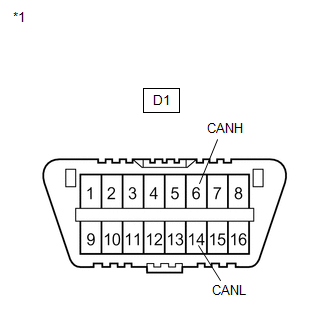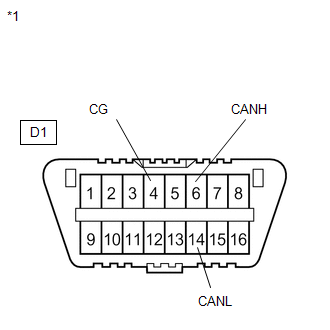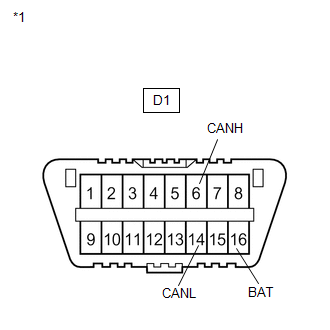Toyota Venza: How To Proceed With Troubleshooting
CAUTION / NOTICE / HINT
PRECAUTIONS WHEN TROUBLESHOOTING
NOTICE:
- DTCs for the CAN communication system are as follows: U0073, U0100, U0101, U0123, U0124, U0126, U0129, U0131, U0142, U0155, U0164, U0182, U0199, U0200, U0208, U0230, U1002 and U1110.
- Refer to troubleshooting of each system if DTCs regarding the CAN communication system are not output.
HINT:
*: Use the Techstream.
PROCEDURE
|
1. |
VEHICLE BROUGHT TO WORKSHOP |
|
|
2. |
CUSTOMER PROBLEM ANALYSIS |
(a) Interview the customer and confirm the problem.
|
|
3. |
CHECK BATTERY |
Standard Voltage:
11 to 14 V
HINT:
If the voltage is below 11 V, recharge or replace the battery before proceeding to the next step.
|
|
4. |
CHECK AND CLEAR DTCS* |
HINT:
- CAN communication DTCs are stored when there is an open or short in any of the communication wires. Any problems with the power source of a corresponding ECU or sensor, or problems in the ECU or the sensor itself also cause these DTCs to be stored.
- If a CAN communication wire connector is disconnected with the ignition switch ON, the ECUs of the corresponding system and related systems store a DTC.
|
|
5. |
CHECK DLC3 BRANCH WIRE AND CAN NO. 1 BUS MAIN WIRE (CANH - CANL) |
NOTICE:
- Turn the ignition switch off before measuring the resistances between CAN bus main wires and between CAN bus branch wires.
- Turn the ignition switch off before inspecting CAN bus wires for a ground short.
- After the ignition switch is turned off, check that the key reminder warning system and light reminder warning system are not operating.
- Before measuring the resistance, leave the vehicle as is for at least 1 minute and do not operate the ignition switch, any other switches or the doors. If any doors need to be opened in order to check connectors, open the doors and leave them open.
HINT:
- Operating the ignition switch, any other switches or a door triggers related ECU and sensor communication on the CAN. This communication will cause the resistance value to change.
- Even after DTCs are cleared, if a DTC is stored again after driving the vehicle for a while, the malfunction may be occurring due to vibration of the vehicle. In such a case, wiggling the ECUs or wire harness while performing the inspection below may help determine the cause of the malfunction.
|
(a) Turn the ignition switch off. |
|
(b) Measure the resistance according to the value(s) in the table below.
Standard Resistance|
Tester Connection |
Switch Condition |
Specified Condition |
|---|---|---|
|
D1-6 (CANH) - D1-14 (CANL) |
Ignition switch off |
54 to 69 Ω |
|
*1 |
DLC3 |
|
Result |
Proceed to |
|---|---|
|
OK |
A |
|
NG (70 Ω or higher) |
B |
|
NG (Below 54 Ω) |
C |
| B | .gif) |
GO TO OPEN IN CAN MAIN BUS WIRE |
| C | .gif) |
GO TO SHORT IN CAN BUS LINES |
|
|
6. |
CHECK FOR SHORT TO GND IN CAN NO. 1 BUS (CANH, CANL - CG) |
|
(a) Turn the ignition switch off. |
|
(b) Measure the resistance according to the value(s) in the table below.
Standard Resistance|
Tester Connection |
Switch Condition |
Specified Condition |
|---|---|---|
|
D1-6 (CANH) - D1-4 (CG) |
Ignition switch off |
200 Ω or higher |
|
D1-14 (CANL) - D1-4 (CG) |
Ignition switch off |
200 Ω or higher |
|
*1 |
DLC3 |
| NG | .gif) |
GO TO SHORT TO GND IN CAN BUS LINE |
|
|
7. |
CHECK FOR SHORT TO +B IN CAN NO. 1 BUS (CANH, CANL - BAT) |
|
(a) Disconnect the cable from the negative (-) battery terminal. |
|
(b) Measure the resistance according to the value(s) in the table below.
Standard Resistance:|
Tester Connection |
Condition |
Specified Condition |
|---|---|---|
|
D1-6 (CANH) - D1-16 (BAT) |
Cable disconnected from negative (-) battery terminal |
6 kΩ or higher |
|
D1-14 (CANL) - D1-16 (BAT) |
Cable disconnected from negative (-) battery terminal |
6 kΩ or higher |
|
*1 |
DLC3 |
| NG | .gif) |
GO TO SHORT TO +B IN BUS 2 LINE |
|
|
8. |
CHECK INSTALLED SYSTEMS (ECU AND SENSOR) THAT USE CAN COMMUNICATION |
(a) Based on the vehicle equipment and specifications, confirm the systems that
use CAN communication (See page .gif) ).
).
|
|
9. |
CHECK ECUS CONNECTED TO CAN BUS* |
(a) Select "CAN Bus Check" from the screen on the Techstream (See page
.gif) ).
).
(b) Observe the screen for approximately 1 minute to check the ECUs and sensors displayed on the screen.
|
Result |
Result |
|---|---|
|
All ECUs and sensors connected to the CAN communication system are displayed on the screen. (CAN bus circuit is currently normal.) |
A |
(Open or short in CAN MS bus main wires.) |
B*1 |
|
All ECUs connected to the CAN MS bus are not displayed on the screen. (Open in main body ECU branch wire or main body ECU malfunction.) |
C |
(Open or short in power management bus main wires.) |
D*1 |
(Open or short in power management bus main wires.) |
E*1 |
|
All ECUs connected to the CAN No. 2 bus and power management bus are not displayed on the screen. (Open in power management control ECU branch wires or power management control ECU malfunction.) |
F |
|
One of the ECUs and sensors connected to the CAN communication system is not displayed on the screen. (Open in ECU or sensor branch wires, or communication interrupted.) |
G |
|
Some ECUs and sensors repeatedly appear and disappear on the screen during this check. (Open in one side of ECU or sensor branch wires.) |
H |
NOTICE:
- The systems (ECUs and sensors) that adopt CAN communication vary depending
on the vehicle and optional equipment. Check which systems (ECUs and sensors)
are installed on the vehicle (See page
.gif)
). - Non-installed ECUs or sensors will not be displayed. Do not mistake them for being in the communication stop mode.
- The ECUs and sensors that repeatedly appear and disappear from the screen during this check are considered normal. (The response to the Techstream and its display are affected by signals output from other ECUs which have an open circuit in either of their CAN bus branch wires.)
HINT:
- *1: See Diagnostic Trouble Code Chart instead of Communication Stop
Mode Table when some of the ECUs connected to the CAN MS bus, power management
bus and CAN No. 2 bus are not displayed on the screen (See page
.gif) ).
). - The ECUs connected to the CAN MS bus are displayed on the screen by the main body ECU.
- The ECUs connected to the CAN No. 2 bus and power management bus are displayed on the screen by the power management control ECU.
| B*1 | .gif) |
GO TO U1002 (MS BUS) |
| C | .gif) |
GO TO MAIN BODY ECU COMMUNICATION STOP MODE |
| D*1 | .gif) |
GO TO U1002 (CAN NO. 2 BUS) |
| E*1 | .gif) |
GO TO U1002 (POWER MANAGEMENT BUS) |
| F | .gif) |
GO TO POWER MANAGEMENT CONTROL ECU COMMUNICATION STOP MODE |
| G | .gif) |
GO TO COMMUNICATION STOP MODE TABLE |
| H | .gif) |
GO TO OPEN IN ONE SIDE OF CAN BRANCH LINE |
|
|
10. |
RECHECK DTC |
HINT:
- Sometimes CAN communication system DTCs are output, but all ECUs and sensors connected to the CAN communication system are displayed on the Techstream. In this case, previous or history DTCs may indicate the cause of the problem.
- ECUs related to a problem in the CAN bus will store DTCs to indicate communication malfunctions. The communication stop mode in the CAN bus can be determined by comparing the combination of DTCs that have been set. Refer to DTC Combination Table for the CAN bus.
- The main body ECU will store communication error DTCs when the ECUs connected to the CAN MS bus cannot communicate, or if a network malfunction occurs.
- The power management control ECU will store communication error DTCs when the ECUs connected to the CAN No. 2 bus and power management bus cannot communicate, or if a network malfunction occurs.
|
Result |
Result |
|---|---|
|
Communication error DTCs other than the codes output from the main body ECU and/or power management control ECU is output. (A malfunction occurred in the CAN No. 1 bus.) |
A |
|
The main body ECU outputs DTC. (A malfunction occurred in the CAN MS bus.) |
B |
|
The power management control ECU (PM1 Gateway) outputs DTC. (A malfunction occurred in the CAN No. 2 bus.) |
C |
|
The power management control ECU (PM2 Gateway) outputs DTC. (A malfunction occurred in the power management bus.) |
D |
| B | .gif) |
GO TO U1002 (MS BUS) |
| C | .gif) |
GO TO U1002 (CAN NO. 2 BUS) |
| D | .gif) |
GO TO U1002 (POWER MANAGEMENT BUS) |
|
|
11. |
DTC COMBINATION TABLE |
(a) Confirm trouble according to the combination of output DTCs regarding the CAN communication system (See page
Click here .gif)
HINT:
Previous CAN communication system DTCs may be the cause if CAN communication system DTCs are output and all ECUs and sensors connected to the CAN communication system are displayed on "CAN Bus Check" of the Techstream.
|
|
12. |
CIRCUIT INSPECTION |
|
|
13. |
IDENTIFICATION OF PROBLEM |
|
|
14. |
REPAIR OR REPLACEMENT |
|
|
15. |
CONFIRMATION TEST* |
| NEXT | .gif) |
END |
 System Diagram
System Diagram
SYSTEM DIAGRAM
1. CAN NO. 1 BUS
2. CAN NO. 2 BUS
3. CAN MS BUS
4. POWER MANAGEMENT BUS (w/ Smart Key System)
...
 System Description
System Description
SYSTEM DESCRIPTION
1. BRIEF DESCRIPTION
(a) The Control Area Network (CAN) is a serial data communication system for
real time application. It is a vehicle multiplex communication system which has ...
Other materials about Toyota Venza:
Front Airbag Sensor LH Malfunction (B1615/14)
DESCRIPTION
The front airbag sensor LH circuit consists of the center airbag sensor assembly
and front airbag sensor LH.
The front airbag sensor LH detects impacts to the vehicle and sends signals to
the center airbag sensor assembly to determine if the ...
Data List / Active Test
DATA LIST / ACTIVE TEST
1. USING TECHSTREAM
(a) Connect the Techstream to the DLC3.
(b) Monitor the ECU data by following the prompts on the Techstream screen.
HINT:
The Techstream has a "Snapshot" function which records the monitored data. Refe ...
Removal
REMOVAL
PROCEDURE
1. REMOVE AUTOMATIC TRANSAXLE ASSEMBLY
HINT:
See the steps from "Remove Engine Assembly with transaxle" through "Remove Automatic
Transaxle Assembly" (See page ).
2. REMOVE AUTOMATIC TRANSAXLE OIL PAN SUB-ASSEMBLY
...
0.1263

.gif)


